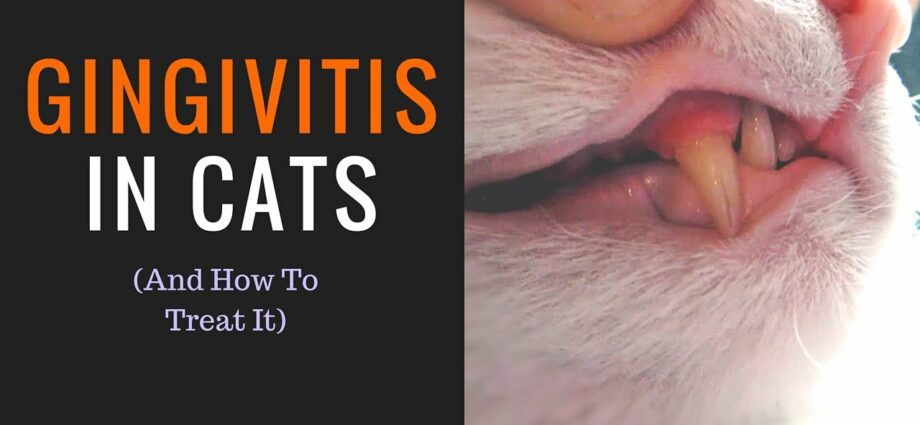Gingivitis in cats: how to treat it?
Gingivitis is one of the reasons for very frequent veterinary consultations. These are very painful oral conditions and the most serious can cause cats to stop eating food altogether. What are the causes of this pathology? How to treat and relieve cats who suffer from it? Can we avoid its occurrence?
Gingivitis, the first stage of periodontal disease
Gingivitis, as the name suggests, is inflammation of the gums. It is a pathology that affects dogs, cats and humans alike. It is mainly due to the formation of tartar on the teeth and the proliferation of microorganisms (bacteria and fungi) that accompany it.
A cat suffering from gingivitis will therefore have a more or less significant tartar deposit on the teeth (greenish to brown material), in particular the canines or the teeth on the side. The gums appear very colorful around the teeth and may be swollen. The affected cat may have pain in the mouth and prefer to eat soft foods.
Periodontal disease
Gingivitis is actually the first stage of what is called periodontal disease. If the disease is allowed to progress, microorganisms can grow deeper in the gum tissue and affect supporting structures in the teeth. This is called periodontitis.
At this stage, the cat very often has bad breath and a sharp pain which causes difficulty in taking food or chewing. He will then chew on one side of his mouth or drop food.
The gums are visually very affected: they have a bright red appearance, are very swollen and some gums may retract. Some teeth can partially loosen, become unstable, or even fall out. The cat can salivate in large quantities and this saliva may contain traces of blood or pus.
This stage of the disease is more serious and cats can stop eating completely, lose weight or become dehydrated.
Gingival stomatitis and other feline features
Cats can also suffer from a more serious disease than the previous ones: chronic feline gingivostomatitis (also called lymphoplasmacytic stomatitis).
Feline gingivostomatitis is a very common condition and a major cause of oral pain in cats. With this condition, there is a very strong inflammation of several different structures of the mouth (the gums, tongue, palate, etc.).
The redness on the gums is distributed symmetrically (on both sides of the mouth) or at the back of the mouth (caudal stomatitis).
This inflammation causes very sharp oral pain. Cats will be very reluctant to eat, show anxiety or annoyance when eating (growl or flap their tails), cry out in pain, or run away quickly after trying to eat.
The full origin of the disease is not fully known. It would start first with a classic periodontal disease then there would be an exacerbated local immune reaction. The involvement of viral agents such as Caliciviruses and Retroviruses (FIV, FeLV) is also suspected.
There is also gingivitis in cats due to systemic diseases such as kidney failure, diabetes and certain liver diseases.
Symptoms of gingivitis in cats
If your cat is showing the following signs:
- Difficulty eating or chewing;
- Important salivation;
- Bad breath;
- Refusal to eat solid foods, etc.
So, it is possible that he is suffering from gingivitis or other oral disease. Present your cat for consultation with your veterinarian who will perform an appropriate clinical examination.
Possible treatments
In the event of gingivitis, treatment often involves dental treatment under general anesthesia: scaling and polishing of the teeth which may be accompanied by tooth extraction if certain teeth are too damaged to be preserved. Adjuvant medical treatment may be prescribed depending on the case: antibiotics, painkillers, etc.
Before performing this procedure, your veterinarian may suggest that you perform examinations to assess the condition of the teeth (x-ray of the teeth) or to remove the hypothesis of an underlying disease (blood test).
In the case of chronic gingivostomatitis, the treatment can be long, tedious and require medical treatment for several days or weeks in addition to dental care.
It is not uncommon for cats to have partial or complete tooth extraction. If your veterinarian suggests it, you should know that cats support this procedure very well and manage to feed with few teeth. The recurrences are much less important and the comfort of the cat is therefore improved in the long term.
Where does tartar come from? How to prevent its appearance and therefore the appearance of gingivitis?
To explain the origin of tartar, we must first talk about dental plaque. Dental plaque is a film of complex proteins that is deposited on the teeth naturally by the action of saliva and food. With the development of microorganisms that are deposited in its breast, dental plaque will gradually calcify and harden, which turns it into tartar. Tartar is therefore a real hotbed of bacteria that causes local infection when it comes into contact with the gums for a long time. This is how gingivitis is born.
The prevention of gingivitis therefore consists in gradually destroying dental plaque by mechanical action or in limiting the proliferation of bacteria using oral antiseptic products.
Several preventive solutions can be implemented on a daily basis:
- Regular brushing of teeth, for this you have to educate your animal from an early age. And yes, this is also possible for cats;
- A solid diet, a diet must contain a portion of solid foods to limit the deposit of tartar and make the gums work;
- Chew toys, like solid foods, regular chewing slows the development of tartar.
Ask your veterinarian for advice on developing one or more of these solutions with your companion.










